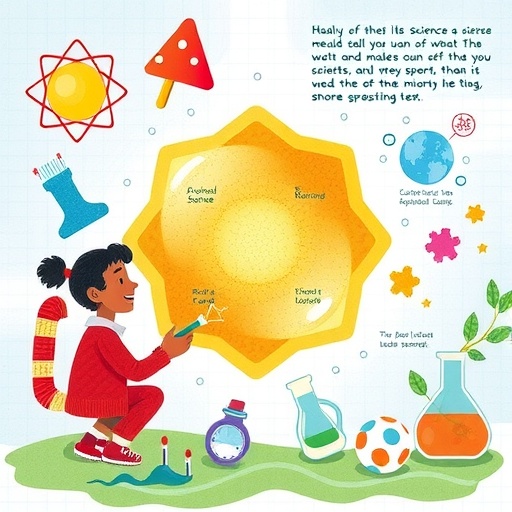In the realm of educational psychology, a groundbreaking meta-analysis has recently shed light on a crucial aspect of learning: the impact of illustrations on students’ science achievement. Conducted by Lei, Chen, and Chiu, this study compiles extensive data to reveal how the integration of visuals alongside textual information significantly enhances students’ understanding and retention of scientific concepts. As educators strive to optimize learning outcomes, this research offers invaluable insights into pedagogical strategies that can bridge the gap between complex scientific principles and student comprehension.
The meta-analysis meticulously reviewed a wide array of studies that examined the relationship between illustrations and learning outcomes in science education. By quantitatively synthesizing data from diverse educational settings, the researchers aimed to present a comprehensive overview of how visual aids contribute to improved academic performance. The findings underscore the importance of utilizing various forms of illustrations, such as diagrams, charts, and images, to supplement textual information, thereby creating a multisensory learning environment that promotes deeper cognitive engagement.
The cognitive theory of multimedia learning lays a conceptual foundation for understanding the mechanisms through which illustrations facilitate learning. This theory posits that individuals process visual and verbal information through distinct channels in the brain, allowing for a more integrated and holistic understanding of complex subjects. By incorporating illustrations into text, educators can capitalize on this dual-channel processing, enhancing students’ ability to encode, retain, and recall scientific knowledge.
One of the key findings of the study is the observed improvement in students’ ability to grasp abstract concepts when exposed to illustrations. Scientific terminology and principles, which can often be challenging for learners, become more accessible when paired with relevant visuals. For instance, a complex scientific process, such as photosynthesis or cellular respiration, can be better understood when students view diagrams that illustrate the steps involved. This visual representation serves not only to clarify the information but also to engage students more effectively, capturing their interest and motivating them to delve deeper into the subject matter.
The study also highlights the importance of the design and quality of illustrations. Illustrations that are well-crafted, contextually relevant, and aligned with educational objectives yield the highest benefits in terms of student learning. Poorly designed visuals can lead to confusion or misinterpretation, ultimately hindering comprehension instead of fostering it. Therefore, educators must be mindful of the way they integrate illustrations into their teaching materials, ensuring that these resources enhance rather than detract from the learning experience.
Moreover, the meta-analysis addresses different demographic variables, such as age and prior knowledge, which can influence the effectiveness of illustrations in facilitating learning. It reveals that younger students and those with less background knowledge tend to benefit more from visual aids compared to their older and more knowledgeable peers. This finding suggests that early exposure to illustrative resources can play a pivotal role in shaping students’ foundational understanding of science, potentially influencing their academic trajectories.
Equally important is the role of context. The effectiveness of illustrations in boosting science achievement is often contingent upon the learning environment and the specific subject matter being taught. For example, illustrations may prove to be particularly beneficial in middle school science classes, where students are beginning to encounter more complex topics. In contrast, high school or advanced courses may require a more nuanced approach to illustration integration, potentially involving more sophisticated representations or interactive elements.
In today’s digital age, the advent of technology presents exciting opportunities for enhancing the use of illustrations in educational contexts. Digital platforms enable educators to incorporate dynamic visuals, animations, and interactive diagrams that can further enrich the learning experience. Such technological advancements can facilitate a more engaging and immersive approach to science education, allowing students to explore concepts in innovative ways.
The findings of Lei, Chen, and Chiu advocate for a paradigm shift in instructional design that prioritizes the inclusion of illustrations in science curricula. As educational stakeholders strive to create environments conducive to effective learning, the research calls for the development of training programs focused on best practices for the integration of visuals in teaching. This would empower educators with the tools and knowledge required to harness the full potential of illustrations in their instructional methods.
Furthermore, it is crucial for curricular designers and policymakers to recognize the implications of this research. By embedding effective visual strategies within science education frameworks, educational systems can promote a culture of inquiry, critical thinking, and sustained interest in scientific exploration among students. This aligns with broader educational goals aimed at fostering a scientifically literate society capable of navigating the complexities of contemporary global challenges.
In conclusion, the meta-analysis conducted by Lei, Chen, and Chiu provides compelling evidence that integrating illustrations into science education significantly enhances students’ academic performance. The layered understanding of cognitive processes, demographic influences, and contextual factors all contribute to a rich narrative advocating for a visual-centric approach to teaching complex concepts. As educators continue to evolve their pedagogical strategies in pursuit of excellence, this research serves as a vital resource that underscores the importance of illustration as an educational tool. By embracing and applying these insights, we can not only improve students’ science achievement but also inspire a generation of curious minds eager to engage with the wonders of the natural world.
Subject of Research: The effects of illustrations on students’ science achievement.
Article Title: Effects of Adding Illustrations to Texts on Students’ Science Achievement: A Meta-Analysis.
Article References:
Lei, H., Chen, L., Chiu, M.M. et al. Effects of Adding Illustrations to Texts on Students’ Science Achievement: A Meta-Analysis.
Educ Psychol Rev 37, 71 (2025). https://doi.org/10.1007/s10648-025-10053-z
Image Credits: AI Generated
DOI: 10.1007/s10648-025-10053-z
Keywords: illustrations, science achievement, educational psychology, meta-analysis, multimedia learning, instructional design.




